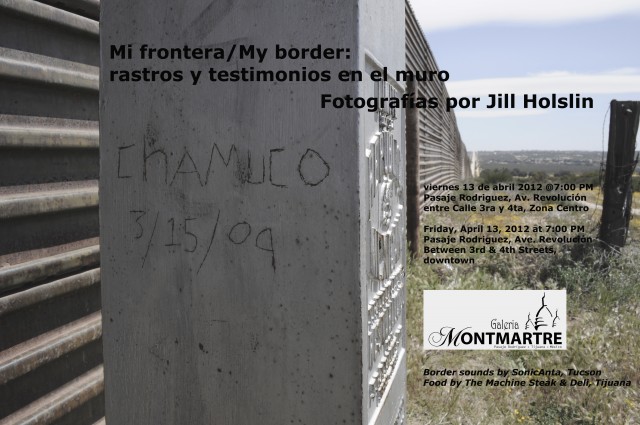 Mi frontera/my border: rastros y testimonies en el muro fronterizo
Mi frontera/my border: rastros y testimonies en el muro fronterizo
Fotografias por Jill Holslin
Esta exhibición de mis fotos del muro fronterizo trata de los mensajes y inscripciones que he encontrado en el muro fronterizo en Baja California y San Diego. He visto mensajes grabados, pintados en el muro aun los mensajes grababos en placas especiales y colgados por estadounidenses que viven en estados muy retirados de la frontera. Estos mensajes manifestan la fuerza con que la gente de los dos lados necesitan hacer una “inversion” en la frontera, como símbolo y realidad. De esta manera, gente de ambos lados puede proclamar que “esta sí es mi frontera.”
En el fondo de una alcantarilla entre Tijuana y San Diego, los migrantes han construido una regadera con un pedazo de manguera, robando el agua de una tubería de la ciudad de Tijuana—diablitos de agua. Aquí esperan a cruzar, platican y cuentan sus historias de viaje.
“Es la última vez que cruzo de mojado,” afirma un migrante, como si escribirlo pueda imaginarlo, y por imaginarlo, lograrlo.
Ellos graban sus nombres, escriben declaraciones del amor, y afirman sus planes para el futuro— por el muro fronterizo. Se convierte el muro en un diaro de la vida de viaje, un documento vivo. En muchos lugares de paso por todo el muro en Tijuana, Campo California, San Diego, Otay Mountain Wilderness, y Tecate, estos rastros sugieren historias de familias, nostalgia para sus pueblos, esperazas para un futuro mejor.
Al este, en el cerro de Tecate, y en la montaña sagrada Kuchama, los nombres y fechas documentan el paso de migrantes por los caminos antiguos de los Kumeyaay o Tipai.
Por el muro en Campo, California, los Minutemen—un grupo anti-inmigrante de voluntarios militares — han organizado un proyecto de colgar placas de metal con mensajes enviados por estadounidenses de lugares muy retirados, estados muy lejos de la frontera. Sus nombres y mensajes revelan ansiedades, la angustia y temor de la gente de EEUU y tambien sentidos compasivos de la gente humilde de los pueblos rurales de Missouri, North Carolina, y Tennessee. Es un síntoma de la gravidad del crisis economico que la gente quieren afirmar su identidad Americana por un vínculo con la frontera.
***** English ****
In the bottom of a filthy culvert between Tijuana and San Diego, a stream of pirated fresh water jets out through a piece of plastic garden hose linked to the city water pipe above, a DIY shower built by traveling migrants. Here they wait, chat, share travel tips for the journey ahead.
And many scratch their names, proclamations of love, and declarations of future plans onto the border wall itself, turning the wall into a living document, a diary of life on the road.
“This is the last time I will cross as a wetback,” affirms one migrant, as though by writing, he is visualizing, and by visualizing, achieving.
This exhibition of my photographs from the border explores messages and inscriptions I have discovered on the border wall in Baja California & San Diego. Messages scratched, painted, and even inscribed onto metal plaques and hung there reveal the ways ordinary people on both sides of the borderline “invest” in the border, as both a symbol and a real place.
In the eastern mountains near Tecate Peak and the sacred mountain Kuchama, names and dates document the crossing of migrants along the centuries-old path of the Kumeyaay. On the border wall at Campo, California, small silver plaques with names and messages bear witness to the good will as well as the anxieties of small town America, as ordinary people from far-off states like Missouri and North Carolina link their identity to the border by hanging a plaque. In key gathering places along the wall in Tijuana, inscriptions suggest stories of families, nostalgia for home, hope for the future.
The show will feature border sounds from the SonicAnta project by Glenn Weyant, Tucson musician and sound artist.
And delicious gourmet finger foods by Victor Rangel of the innovative new restaurant The Machine Steak & Deli, located on Blvd. Aguacaliente, Tijuana.
Please join us!
When: Friday, April 13, 7:00 PM until closing
Where: Galería Montmartre, Pasaje Rodriguez, Tijuana
Downtown Tijuana, on Revolución, Between 3rd & 4th Street
How to get here: Take the 5 South to the “Last U.S. Exit” at Camino de la Plaza. You can park here on the U.S. side of the border and walk easily across to the taxi stands waiting on the other side. A taxi will take you directly to “Avenida Revolution,” and you will find Pasaje Rodriguez between 3rd and 4th street.
Pasaje Rodriguez is an indoor, open-air market along the original tourist strip of the city of Tijuana, now being revitalized by artists, foodies, artisanal beer brewers and cultural entrepreneurs of all kinds. Here you will find galleries, bookstores, coffeeshops, clothing boutiques and a graffiti & urban art store. Very little of the stereotypical offerings of the old Tijuana curios and souvenir shops are here. But if you want that kind of thing, you can definitely find it out on the street!
And Galeria Montmartre is a new gallery and working art studio in the Pasaje, owned by artist Anabell Santellanes and opened just last fall. Galeria Montmartre features painting, photography and graphic design work by local artists. Like Galeria Montmartre on Facebook!
